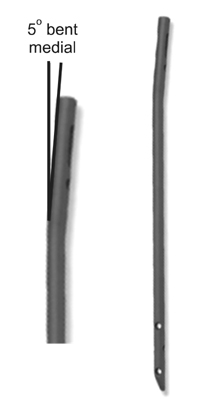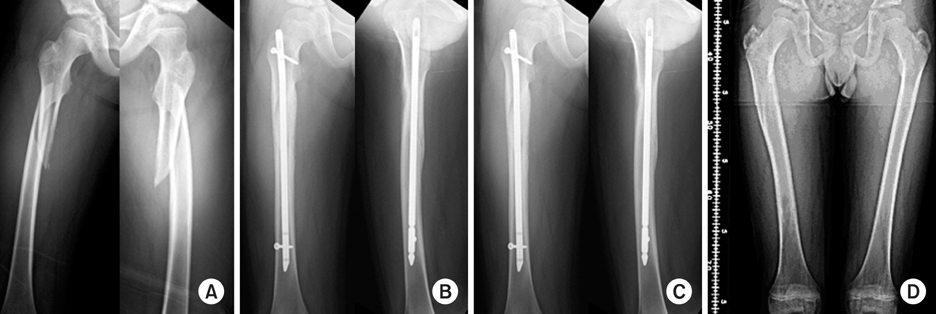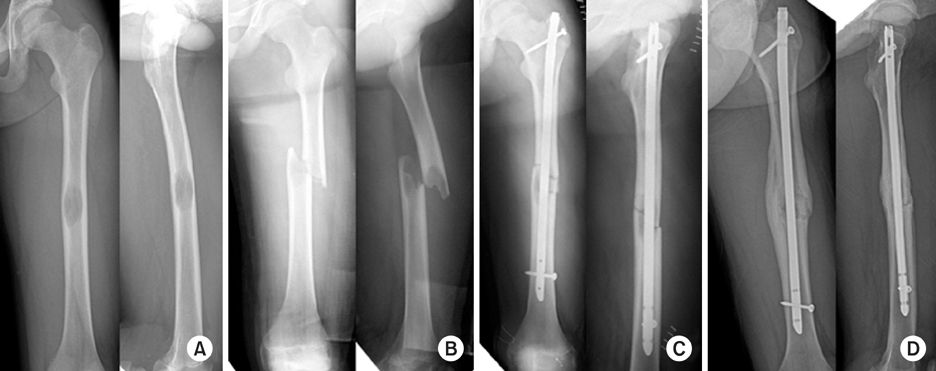Articles
- Page Path
- HOME > J Musculoskelet Trauma > Volume 23(2); 2010 > Article
-
Original Article
- Treatment of Femoral Shaft Fracture with Interlocking Humeral Nail in Older Children and Adolescent
- Kun-Bo Park, M.D., Hoon Park, M.D., Hyun-Woo Kim, M.D., Hui-Wan Park, M.D., Jae Young Roh, M.D.
-
Journal of the Korean Fracture Society 2010;23(2):206-212.
DOI: https://doi.org/10.12671/jkfs.2010.23.2.206
Published online: April 30, 2010
Department of Orthopaedic Surgery, Haeundae Paik Hospital, Inje University College of Medicine, Busan, Korea.
*Department of Orthopaedic Surgery, Yonsei University College of Medicine, Seoul, Korea.
†Department of Orthopaedic Surgery, Konyang University College of Medicine, Daejeon, Korea.
- Address reprint requests to: Jae Young Roh, M.D. Department of Orthopaedic Surgery, Konyang University Hospital, 685, Gasuwon-dong, Seo-gu, Daejeon 302-718, Korea. Tel: 82-42-600-6903, Fax: 82-42-545-2373, jyroh@kyuh.co.kr
Copyright © 2010 The Korean Fracture Society
- 471 Views
- 2 Download
Abstract
-
Purpose
- To evaluate the results of interlocking humeral nail for femur shaft fractures through the greater trochanter in older children and adolescent.
-
Materials and Methods
- Eleven femoral shaft fractures in ten patients were selected. They were consisted of 9 boys and 1 girl. Two patients had osteogenesis imperfecta and one patient had a simple bone cyst as an underlying disease. 7 cases were right side and 4 cases were left side. The mean age at the time of operation was 12 years and 7 months (8 years 11 months~15 years 7 months). The mean follow-up period was 21 months and interlocking humeral nail was inserted at the greater trochanter in all patients.
-
Results
- All patients had a complete bony union without any complication such as infection, nonunion, leg length discrepancy and metal failure. Avascular necrosis of femoral head and coxa valga were not developed in all patients.
-
Conclusion
- Intramedullary nailing through the greater trochanter using interlocking humeral nail is effective and safe treatment for the femoral shaft fracture in older children and adolescents.
- 1. Aronson J, Tursky EA. External fixation of femur fractures in children. J Pediatr Orthop, 1992;12:157-163.Article
- 2. Astion DJ, Wilber JH, Scoles PV. Avascular necrosis of the capital femoral epiphysis after intramedullary nailing for a fracture of the femoral shaft. A case report. J Bone Joint Surg Am, 1995;77:1092-1094.Article
- 3. Beaty JH, Austin SM, Warner WC, Canale ST, Nichols L. Interlocking intramedullary nailing of femoral-shaft fractures in adolescents: preliminary results and complications. J Pediatr Orthop, 1994;14:178-183.Article
- 4. Buford D Jr, Christensen K, Weatherall P. Intramedullary nailing of femoral fractures in adolescents. Clin Orthop Relat Res, 1998;350:85-89.Article
- 5. Carey TP, Galpin RD. Flexible intramedullary nail fixation of pediatric femoral fractures. Clin Orthop Relat Res, 1996;332:110-118.Article
- 6. Corry IS, Nicol RO. Limb length after fracture of the femoral shaft in children. J Pediatr Orthop, 1995;15:217-219.Article
- 7. Galpin RD, Willis RB, Sabano N. Intramedullary nailing of pediatric femoral fractures. J Pediatr Orthop, 1994;14:184-189.Article
- 8. Gausepohl T, Pennig D, Koebke J, Harnoss S. Antegrade femoral nailing: an anatomical determination of the correct entry point. Injury, 2002;33:701-705.Article
- 9. Georgiadis GM, Olexa TA, Ebraheim NA. Entry sites for antegrade femoral nailing. Clin Orthop Relat Res, 1996;330:281-287.Article
- 10. González-Herranz P, Burgos-Flores J, Rapariz JM, Lopez-Mondejar JA, Ocete JG, Amaya S. Intramedullary nailing of the femur in children. Effects on its proximal end. J Bone Joint Surg Br, 1995;77:262-266.
- 11. Gordon JE, Khanna N, Luhmann SJ, Dobbs MB, Ortman MR, Schoenecker PL. Intramedullary nailing of femoral fractures in children through the lateral aspect of the greater trochanter using a modified rigid humeral intramedullary nail: preliminary results of a new technique in 15 children. J Orthop Trauma, 2004;18:416-422.
- 12. Gordon JE, Swenning TA, Burd TA, Szymanski DA, Schoenecker PL. Proximal femoral radiographic changes after lateral transtrochanteric intramedullary nail placement in children. J Bone Joint Surg Am, 2003;85:1295-1301.Article
- 13. Hansen ST. Internal fixation of children's fractures of the lower extremity. Orthop Clin North Am, 1990;21:353-363.Article
- 14. Kuntscher G. The intramedullary nailing of fractures. Clin Orthop Relat Res, 1968;60:5-12.
- 15. Lee SH, No W. Treatment of choice in the surgical management of the femoral shaft fractures in children: elastic intramedullary nailing. J Korean Fract Soc, 2008;21:176-179.Article
- 16. Litt R, Albassir A, Willems S, Debry R. [Coxa vara. Isolated growth of the greater trochanter. Prevention-treatment]. Acta Orthop Belg, 1990;56:301-306.
- 17. McConnell T, Tornetta P 3rd, Benson E, Manuel J. Gluteus medius tendon injury during reaming for gamma nail insertion. Clin Orthop Relat Res, 2003;407:199-202.Article
- 18. Mileski RA, Garvin KL, Huurman WW. Avascular necrosis of the femoral head after closed intramedullary shortening in an adolescent. J Pediatr Orthop, 1995;15:24-26.Article
- 19. Momberger N, Stevens P, Smith J, Santora S, Scott S, Anderson J. Intramedullary nailing of femoral fractures in adolescents. J Pediatr Orthop, 2000;20:482-484.Article
- 20. Oh CW, Park BC, Park HJ. Retrograde flexible intramedullary nailing of pediatric femur fractures. J Korean Soc Fract, 2001;14:272-277.Article
- 21. O'Malley DE, Mazur JM, Cummings RJ. Femoral head avascular necrosis associated with intramedullary nailing in an adolescent. J Pediatr Orthop, 1995;15:21-23.Article
- 22. Raney EM, Ogden JA, Grogan DP. Premature greater trochanteric epiphysiodesis secondary to intramedullary femoral rodding. J Pediatr Orthop, 1993;13:516-520.Article
- 23. Timmerman LA, Rab GT. Intramedullary nailing of femoral shaft fractures in adolescents. J Orthop Trauma, 1993;7:331-337.Article
- 24. Townsend DR, Hoffinger S. Intramedullary nailing of femoral shaft fractures in children via the trochanter tip. Clin Orthop Relat Res, 2000;376:113-118.Article
- 25. Winquist RA, Hansen ST Jr, Clawson DK. Closed intramedullary nailing of femoral fractures. A report of five hundred and twenty cases. 1984. J Bone Joint Surg Am, 2001;83:1912.
- 26. Ziv I, Blackburn N, Rang M. Femoral intramedullary nailing in the growing child. J Trauma, 1984;24:432-434.Article
REFERENCES


Figure & Data
REFERENCES
Citations




Fig. 1
Fig. 2
Fig. 3
Summary of cases
*OI: Osteogenesis imperfect, †SEP: Static encephalopathy, ‡SBC: Simple bone cyst, §TA: Traffic accident, ∥EDH: Epidural hematoma.
Results
*NSA: Neck shaft angle, †ATD: Articulotrochanteric distance.
*OI: Osteogenesis imperfect, †SEP: Static encephalopathy, ‡SBC: Simple bone cyst, §TA: Traffic accident, ∥EDH: Epidural hematoma.
*NSA: Neck shaft angle, †ATD: Articulotrochanteric distance.

 E-submission
E-submission KOTA
KOTA TOTA
TOTA TOTS
TOTS



 Cite
Cite

